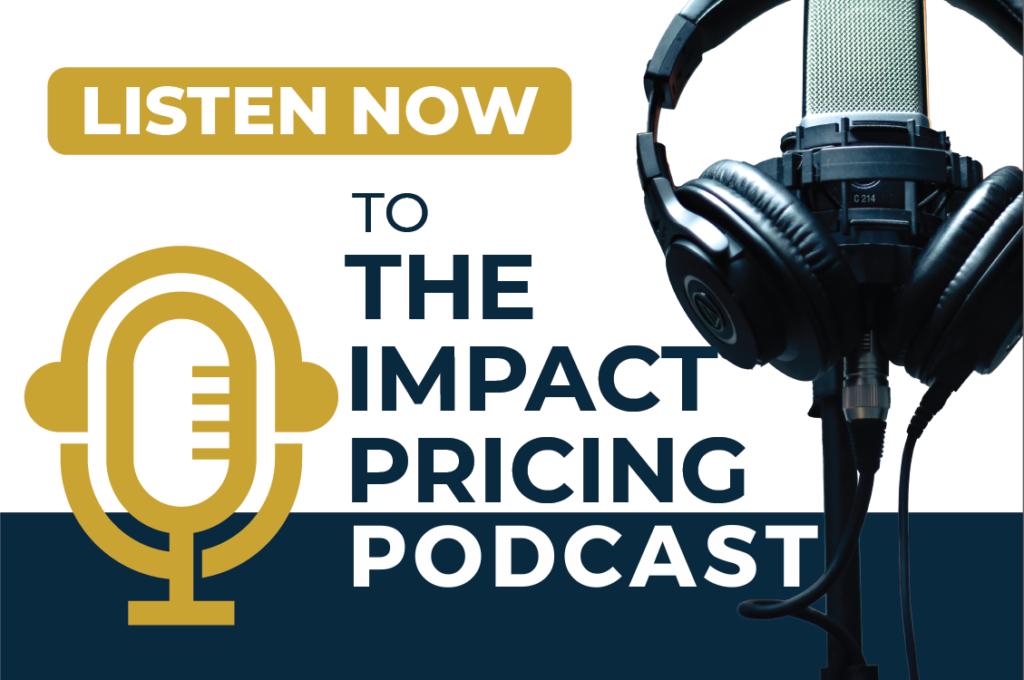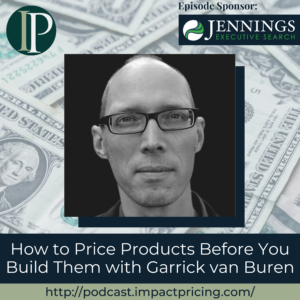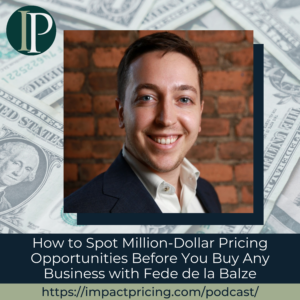Daniel Cho has over 29 years of experience in the healthcare industry, currently serving as the Senior Director of Global Pricing at Philips Healthcare. With a background in sales, product management, and pricing strategy, Daniel has a unique perspective on how to effectively communicate value to customers and drive profitability.
In this episode, Daniel shares his journey into pricing and the critical importance of understanding the value your product delivers to customers. He emphasizes that pricing should not just be about features but about the economic, operational, emotional, clinical, and societal value that resonates with different stakeholders. Through real-world examples, Daniel illustrates how a well-structured pricing strategy can lead to stronger, more profitable relationships.
Podcast: Play in new window | Download
Why you have to check out today’s podcast:
- Discover the five key value drivers that can transform your pricing strategy and enhance customer relationships.
- Learn how to effectively communicate value to different stakeholders within a healthcare organization, from CFOs to clinical staff.
- Gain insights into structuring contracts and pricing metrics that align with customer needs and perceptions of value.
“Resist on the discount as much as possible. Look for every other ways to solve it rather than the discount. The discount should always be a last resort and not the first thing you want to deliver or give.”
– Daniel Cho
Topics Covered:
02:33 – Daniel’s journey into pricing
03:23 – The power of pricing strategy, using segmentation and perceived value to differentiate identical products for distinct markets
06:58 – How two identical products can be integrated differently with existing pricing ecosystems
07:57 – Leveraging his expertise in data analysis to establish Philips’ first pricing department
12:11 – Initiating a value-based approach at Philips to create, price, and articulate value
14:22 – Defining value and discussing the 5 key value drivers in a health organization
18:03 – Tailoring value propositions and demonstrating how those four other value streams ultimately lead to financial and strategic benefits
25:22 – An effective sales training Daniel created that teaches salespeople to tailor value-based pitches to different stakeholders’ priorities
31:27 – Daniel’s best pricing advice
Key Takeaways:
“We cannot continue to sell features and benefits, we have to go and sell value.” – Daniel Cho
“If the product is not value-based, you can’t ask the salespeople to sell value because you have to start from the product that actually deliver and generate value. So, we started from the product managers.” – Daniel Cho
“The first one is economic value. Very simple. Help me to make more revenue or help me to save costs so I have an economic benefit.” – Daniel Cho
“The next value is the emotional value. How can we create a better experience for the patients and also their own staff so the staff don’t get burnout.” – Daniel Cho
“Financial value, although as strong as it is, doesn’t resonate with everyone.” – Daniel Cho
“Stop giving discounts for free. Always get something back from the customer.” – Daniel Cho
People/Resources Mentioned:
- Philips Healthcare: https://www.philips.com/
- Apple Watch Launch: https://www.apple.com/
- Bausch and Lomb Contact Lens Case: https://www.bausch.com/
Connect with Daniel Cho:
- LinkedIn: https://www.linkedin.com/in/danielkkcho/
Connect with Mark Stiving:
- LinkedIn: https://www.linkedin.com/in/stiving/
- Email: [email protected]
Full Interview Transcript
(Note: This transcript was created with an AI transcription service. Please forgive any transcription or grammatical errors. We probably sounded better in real life.)
Daniel Cho
Resist on the discount as much as possible. Look for every other ways to solve it rather than the discount. The discount should always be a last resort and not the first thing you want to deliver or give.
[Intro / Ad]
Mark Stiving
Welcome to Impact Pricing, the podcast where we discuss pricing, value, and the direct relationship between them. I’m Mark Stiving, and I run bootcamps that help companies get paid more. Our guest today is the one and only Daniel Cho. Here are three things you want to know about Daniel before we start. He is the Senior Director of Global Pricing at Philips Healthcare. He’s been at Philips, it looks like 24 years, and he’s been in healthcare for 29. And he’s been in healthcare for 30, probably 34 now, since my math is off. He’s done stints in sales and product management before becoming a pricing guru. And probably my favorite thing about Daniel is that he is a frequent commenter on all of the content I put up on LinkedIn. So most of the time, we agree. Once in a while, we disagree. So welcome, Daniel.
Daniel Cho
Thank you. And I mean, almost like we know each other for a century. And we communicate a lot through the LinkedIn post. So I mean, I think we know each other quite well. I hope the audience also sometimes can see my posts. So I actually started off my first job as a Price Waterhouse Consultant for Management. So that is really where everything starts, you know, to be able to help people solving problems. So that is something that you had not mentioned.
Mark Stiving
Yeah. Isn’t Pricewaterhouse mostly an accounting firm? They do accounting work?
Daniel Cho
Yes, that was what I thought. But then when I put in my application, they actually had a management consultancy. So it’s in Sydney. Actually, it’s called Pricewaterhouse Irvik. So they merged with Irvik to create this management consultancy branch of it. Until today, they still have this branch. And I was mainly in the IT side because I graduated as a computer scientist.
Mark Stiving
Well, that begs the question, how did you get into pricing?
Daniel Cho
So it’s actually a funny story because initially I had my first part of my career as a selling person. So I actually go and sell. So I interact with tenders. I interact with customers B2B. mainly and also big selling groups and also government. Then one day I got very tired of selling after almost 15 years of that. Then I find a position in Germany where I’m now at for the last 20 years for product management. So I’m creating products or innovation so that we we can sell. And in creating of that product, I have to price it. And then I was reading a lot of books to learn what is the right way to price it. And I actually come across a very interesting launch of Apple at the time they just launched their Apple Watch.
And then they are able to differentiate the same watch, same technology into three segments. So they have this competing with sports, you know, this Garmin competitor model, as well as they have this really, really expensive classical model that they are selling. And I look at it, I said, my God, I mean, it is possible to sell the same product at different segments, as long as you clearly defined it, then you can determine the right price for it. The most expensive version of that watch is 50.50 times the cheapest sports watch. with no feature differences. So that inspired me at that time as a product manager. When I launched my product, I actually created two very distinct segments. One is in the hospital and one is outside the hospitals. And they normally do not talk. I mean, our hospital is like the military, you sell to ambulances and then you sell to other facilities. that are mainly, you know, transport patient from one place to the next.
So military, they transport patient from the battlefield, you know, back to the army camp. And then you have the in-hospital, which is really transporting a patient from maybe from the critical care to take a MRI image and then come back, or they go to surgery and then come back. And then the workflow that we design in the hospital is very strong. We can save people five minutes per travel. And based on that value, that means they can actually perform more operations in a day and they can save also the energy of the nurses. So we know there is a very different value and we use market research to prove that people are willing to pay more. So when we launched it, we set the price difference at 15%. So the exactly same product, but the one that is selling in the hospital is 15% more than the one that is selling outside. We actually created two completely different brochures, two different product numbers, two different names even.
One is called MP2, one is called X2. So to most people, even internally, they don’t know this is the same product. And we use completely different value proposition. One focus on workflow, the other is focusing on ruggedness. And the fact that you can use, you know, in all weathers, whether it’s raining or, you know, and then you can use it on fixed wing, on rotary wings, like helicopters. And all these are proven, you know, to work. We have tested everything. So same product selling completely different and achieving different price. So the fun fact is that the one in hospital, because the value is so high and the value did not change, we have zero price erosion for the entire lifetime of the product.
So this is over 12 years. We have the same price or even sometimes improved price over time. On the hour of hospital segment, because there’s a lot of competition and also the various proposition is not too strong. Everyone can copy to be a robust model. So at the end, we actually have a depreciation. So the erosion is about 1 to 1.5%. So, and at the end, there’s such a big price gap between the two after the product is going to almost end of life. And that’s funny because that’s when I start thinking about, wow, you know, you can actually influence the perception of that price and keep it strong even when the, I mean, when the product is still the same. So that’s where I start to think about pricing. Yes.
Mark Stiving
I think that’s a great story. Can I ask you, are you familiar with the Bausch and Lomb story where they got sued because they were selling the exact same contact lens as a daily wear and a 30 day wear? It was just a matter of how they packaged it and sold it, but it was the exact same lens.
Daniel Cho
So we are lucky because we support the workflow and the workflow has to be connected to entire system, you cannot have that workflow. So with that workflow, and this is where a customer is paying for, you can’t do it outside the hospital. So it is a very clear cut. That’s why we create a complete two different products, because one work with the ecosystem, one will not. Even if you bring the hospital monitor into the hospital, you cannot work with the ecosystem. It’s designed in that way. So there is a clear cut of the value.
So one has that value, one will not have that value. And this is how we differentiate the two products and the price. So I had that for a while. So three years, I was the product manager. And after I launched the product, I got bored. So I asked the management, you know, is there one position that I can have that is helping me to learn how to manage a team or at least a person? Because for my entire life until then, it was always selling or managing a product. So then I was given a very small department called market intelligence. At that time, it was only one staff, myself and one analyst. And then we started off market intelligence. And then for market intelligence, I played with data. There’s a lot of data and a lot of competition data, a lot of our own pricing data. And from learning how to use it, I start investing a lot on click view visualization.
And one day I walked into the office of the financial controller of the business. I said, do you know you have a horrible pricing performance? And he asked me, why do you think like that? And I said, because I look at your pricing, it is so scattered. That’s no logic behind and you basically are leaking prices everywhere. And he say, show me, then I start showing him. And then I say, you know, if you can improve on this few areas, your price and also your profitability will improve a lot. And he said, OK, looks great. So can you do it for me? I said, if I am going to do it for you, then I have to create a pricing department. And I have to own, also my own analytic platform. So you have to give me some investment. So a small investment to create a department called pricing. At that time, Philips do not have a pricing department. So I started the first, and then he give me this 250K startup funding, you know, so that I can develop all the analytics that I need. The first year we made a serious impact on the profitability of India as the pilot.
We just said, let’s go to India, let’s do something there just to show you how it works. And then we even won an award based on that, an internal to Philips, a management award. And then he said, can we have more? I said, yes, give me more analysts. Then I can give you more. So this is how I build a team from one analyst and myself. At the end, I think at the peak, I had 12 analysts working for me. And then later on, I only do this business. And they keep asking me to do more and more business line. At one point in time, they say, can you cross to the other ocean, which is imaging, because we were more patient monitoring and connected care. And I had been already at the head of that part. They say, Yeah, you did it so well here, but the problem is not here.
The problem is actually over the other ocean, which is the imaging side. I said I will not do it unless, you know, I am giving even more authority because I think that problem is so big. If you throw me across the fence and I do not have that backup from the executive and I have the authority, I will just you know, die immediately. I mean, this is the deeper side of the of the pool. So they gave me a significant promotion. So that’s where I got my senior director and also a lot of backing because they know how difficult it is. So they gave me a target, which I cannot say here, to achieve within two years. And we did make it. But it was, they give me the authority to create a completely brand new team. So I actually recruit my A team myself. I pull people in. So that’s how I started pricing, yes.
Mark Stiving
One of the things that’s fascinating about the story you just told is that you kept getting promoted and kept getting more and more authority as you were delivering impact, right, as you’re delivering value to the company. And one of the things that we said we wanted to talk about was this concept of selling value. And so you’re delivering value and selling value internal to Philips, but now we’ve got to help the Philips salespeople be able to communicate and sell value. Absolutely. So what do you do in that aspect?
Daniel Cho
So in order to do that, and I make that decision that we have to become a value-based company. Four years ago, so more or less four years ago, I said, no, we have to be, we cannot continue to sell features and benefits, we have to go and sell value. So, and we know we can’t start from the salespeople because if the product is not value-based, you can’t ask the salespeople to sell value because you have to start from the product that actually deliver and generate value. So we started from the product managers. So we start creating a 12-hour training.
And until today, we’re still doing that. And then we ask product managers to come in and we train them for the 12 hours from end to end, how they create value, how they price on the value, how they can create the right product structure, even to capture the value. And at the end, how do you communicate the value to your end customers? So when they launch new product, when they build, even when they relaunch even the older product, they have to have this articulation ability to communicate that value to their customers. Then the next stop, which is we started last year, we then go and teach all the salespeople to communicate value.
Mark Stiving
Before we jump to sales, let me ask you about product management. Actually, just let me ask you about value. When you define value and say product managers, you guys have to be able to articulate value. In the end, is value incremental profit to your customer?
Daniel Cho
Not only that. So we decided Because we really think very deep. We say, okay, how do the customer actually perceive value? So we talk to a lot of customers. I say, what do you want from Philips if we are going to do something for you? What are the areas that I can help you? Everyone was talking about solving problem. Of course, it’s solving problems. But I say, which problem to solve that you can feel that we are doing something great for you? And then at the end of all this interview, we find out there are five streams of value that customers say, if you give me, if you deliver to me in this way, I will perceive it. I understand what you do. I understand what you give me and I will be willing to pay for it.
So the five value, the first one is economic value. Very simple. Help me to make more revenue or help me to save costs so I have an economic benefit. This is the easiest to quantify. You don’t need a lot. You can calculate a lot. If you have more patients, patients bring in some kind of reimbursement, then that is increasing your revenue. If you do not do errors, if you don’t do mistakes, if you can do things faster, easier, you have less cost. So this is the easiest to calculate and to present. The second one is operational. So in this world and time, the biggest challenge every hospital has is post-COVID, they lose a lot of nurses and doctors and radiologists.
So they have a lot of patients to treat, but they do not have enough resources. So they need to have a better operation. So they do need to do more with less resources. So that’s where you need a lot of automation. I mean, you hear a lot about AI. It is about this fastest, do things faster without mistake, you know, making sure the human only do the care. Everything else should be taken care by the machine. So this operational improvement, the fact that they can hire less people, but still take care of so many patients, this is huge value to the hospital, especially now. I mean, now they say, if you can save me one nurse, I’m going to pay you a substantial amount because recruiting a nurse actually is $25,000. just to recruit one new nurse. And they keep losing nurses because of a lot of stress they are currently having.
So the ability, and this is one of the next value, is the emotional value. How can we create a better experience for the patients and also their own staff so the staff don’t get burnout and the IT don’t get cyber threats. so they can be easy and they can have a very easy working environment. So this is very important because with a much better experience, the patient will come back, they will recommend also their family and friends. If you have a problem, you come to this hospital instead of every other hospital. So helping the hospital to recruit and retain more such patients. So emotional is very important and emotion also is the one that is connected really well with operation.
So if everyone feels good, they will work faster, they will work without mistake. So that’s a lot of connectivity. And of course, if you have a better operation, you also have financial benefit most of the time. If you can move a patient faster so that you can have two more patients per day, you also will have more money. So a lot of this value, although it’s communicating in a different way, eventually also contribute to the financial. So the fourth value driver is the clinical. Of course, we are in the healthcare business, you want the patient to be better at the end of the day. You want them to have the first time right diagnosis. You want them to have the first time right treatment. You want them to reduce the length of stay in the hospital. You want them to have reduction in potential infections or whatever. You know, bad things that can happen in the hospital.
So all these are clinical benefits, which we can claim and we can claim with evidence. We have a lot of clinical studies to back up when we launch the product. So this is another really important one. And of course, if you talk to the doctors, they look at clinical. If you talk to the CFO, he will not. So it’s not a kind of a silver bullet. But majority of the cases, strong clinical value does come with a very strong financial for us.
Mark Stiving
Yeah. On the other side of that exact same coin, when you talk to doctors, they don’t care about the financial.
Daniel Cho
They only care about the clinical. They do not. Yes. Of course, they do not. So we need to help them to build strong business cases. So first, the doctor has to like your product. Then they have to apply for the budget. And of course, Philips is not the cheapest one. So they need to find a very strong reason to invest into a very, very good machine like Philips and not buying some very inexpensive Asian products. So in order to convince their management, which could be the CFO, we have to give him the business case. And the business case needs some financial and operational value attached to it.
So this is also bottom up that you help the doctor who is never good, strong in financial, never strong in operational, can have the right tools to fight for this better machine that help him to do better clinical at the same time, deliver fantastic result also for their CFO, CEO, CIO, and everyone is happy at the end. The last but not least is getting stronger and stronger by the year is this sustainability. So the societal value, providing more access to care to the whole population rather than the elites and also the ones living in the city. the fact that you are using less energy, the fact that you create less CO2 footprint, the fact that you are using more recyclable products, less dumped into the landfill. I mean, all this is more and more important. And customers actually prefer, and especially in Nordics, they actually put it in the tender that if you are not a sustainable company, they will not buy from you. And also they themselves want to be a sustainable hospital.
So they also want to say, if I buy, what can I claim through this purchase that I am also reducing my own CO2 footprint, my own recycling and all that. So this is really the five value driver that resonate with everyone we talk to. So when we go back to the product manager, we will say, consider yourself. So whose problem are you solving? and how much you solve it, and tell me through these five lenses. Can you tell me how much financial you help the hospital to make, or operational, or clinical, or emotional, or this societal? If you cannot explain to me these five, go back and rework, because we need at the very end the way to communicate to my customers.
Mark Stiving
I love that. That was beautiful. Now, if I were going to interpret it the way I would normally think, I would put financial at the top and say, look, you know, it’s all about the money. How much money am I going to go make the hospital? But we get there through these other results that we’re looking at, right? So, we get there through operational, emotional, clinical, sustainable. And so, this is how we deliver financial results. And if we just say to a hospital, hey, we make you more money, they don’t believe us, they don’t care.
But when we say we help you be more effective or we help you not have to hire more nurses or whatever it happens to be, now we’ve got proof points and it’s easier for us to go sell this to a hospital or to anybody. So we have to be more specific than just, we make you more money, but you can’t be so specific that says, hey, we fix this specific problem for this specific type customer, right? That’s just too specific and it doesn’t really resonate with our buyers.
Daniel Cho
And financial value, although as strong as it is, it doesn’t resonate with everyone. So if you go into a hospital, you have to deal with so many people. And a lot of them are clinical people. A lot of them are the ground staff, the nurses themselves. And you need to communicate different ways to them, so to get them to support you to start with. And this is really where we believe, you know, financial is not the answer. I mean, I actually talked to the CFO of NHS. NHS is the national health system in UK.
So we asked him, what is the biggest problem of that time? And he really say, you know, it is nurses. I mean, we need to retain my nurses. It’s very difficult to keep them. And I say, you know, we have a way to remove a lot of stress by reducing the effort, you know, to do the scanning. And by doing this, you know, you require much less nurses or the nurses do not have to do these tedious things. they can focus on the patient, help the patient to prep better, then also speed up the scanning. So that’s a lot of things that you can save. One of the things that you can save is also the time, which means that your staff do not have to work overtime. So they can relax, they can go home, have meals with their kids.
Also that will relax and create emotional safety. He is very interested in time. He said, wow, okay, tell me more about time. But he said time itself is not important. Tell me what you can use the time for so that I can see and then I can explain to him time can be used in multiple ways. The first one, of course, you can use the time to have more patients to be scanned. That helps you to make money. So he is interested in that, of course. And I said time also can improve the quality because you are not in a hurry. you can prep the patient better, you can prep your technician better, the image will be perfect every time it comes out. You don’t have to recall the patient back because the preparation was not good, it’s not aligned well.
So all this possibility of a rescan is not there. So you save a lot of costs, you save a lot of operational mistakes. And then I said, the time can also be used to reduce your overtime because you’re paying overtime. And overtime is big in UK, you pay one and a half times the normal salary when it’s overtime. I said, you also save costs there. If you ask them all to go home earlier, you save there. If you ask them not to go home, but then you can scan more patients, you can get money from that side. So you get it from either side. You decide.
And then I say time can also be used for training, education. You can spare that time for the workers. They can be trained better so that they can even be more comfortable with the operation. They can even do things better, faster. So I think when we save the time, if you reinvest your time in the right way, you can always bring at the end your financial that you need as a financial controller. And this is how you can connect everything back to his KPI. But you have to convince him it is workable.
So you have to use other KPI like time to convince him that time is where you have to believe it will work because the time can bring you money in each direction. And you have choice. It’s not like I dictate you how you do it. You have different choices you can adopt. and best for your own hospital, or even multiple hospitals, because he owns a lot of hospitals. Each hospital has an opportunity to use that save time to generate money for you as a controller. So those are the kind of discussion we are now educating the salespeople to take, to think first, who is this person? What is his KPI? And how can we make sure that we can convince, we can help him with his KPI. So he will get a bonus and he get a promotion at the end by his own performance. But you have to explain it in these five contexts so that it’s make it easier to remember and understand.
Mark Stiving
So we’re running out of time, but let me, we haven’t talked about training salespeople hardly at all. You can kind of infer that what we just talked about was training salespeople, but what does a sales training look like for you guys?
Daniel Cho
So self-training is a three-hour training, but before that, they have to do some pre-read, not more than one hour. So we have an e-module, so it’s called the Power of Pricing. So everyone has to understand what pricing means, what value-based pricing means, and some of these concepts. Who are the personas that you are working with, and what are their interests? So some very basic things is educated as a pre-read. When they come into the training, then it’s two hours, very solid, explanation first is to tell them how to explain the value.
So these five value drivers and also other examples and show how other companies are using different ways to communicate value. And we show them different examples inside, outside, whether it’s equipment, whether it’s a service, you know, you can create different arguments and talk about value. And then the next one is tell them how you trade value with price. you must have a prepared negotiation process. You can’t jump into the selling and immediately have everything. So we designed a two axis. One axis is how important is this to your customer?
So how much they value that thing that you are going to sell? And then how much is important for Philips? How much cost we have to bring in in order to deliver? So everything is into these two axis. And then based on this, we train them, what do you do in this? So you have four quadrants and you go around the quadrants and in each quadrant, that is a strategy and how much you need to get back in order to make this, you know, to make the balance and the equilibrium between the negotiated and also the negotiator. So this is part of the most fun is able to help them to think like that, to have a structured way. And also thinking about who I’m talking to, what is his KPI, why I need to talk to him like that.
So after the training, I can give you the comment of these salespeople. Of course, they say this is the best sales training we ever had because it’s so practical. And these people say, I have never the guts to go to a CEO because he is not interested in my product at all. He’s not interested in my pitch. My features mean nothing to him. He give me only three minutes to talk, maximum five minutes. I have not even finished talking about my first feature. Time is up. And I get slapped on my face every time I visit him. So I’m so scared. I don’t know what to do. But after the training, now I can easily create elevator pitch that he love to hear. and all based about the value that he wanted rather than the feature. And he said, you help me to think about the cakes that we can bake for him instead of focusing on the oven.
So this is actually coming from the salesperson. He said, now I know how to sell the cake. And he want the cake, he don’t want the oven. But every other day we were trying to sell the oven to him. And that’s why he’s not interested. And I said, yes, you are almost like pushing sometimes even the steak to the vegetarian. When you talk about clinical to the CFO, when you talk about money to the head physician, you are pushing meat to the vegetarian. So you always get this resistance because you don’t understand who you’re talking to, what value they want. And how can you even communicate that value to him? Now, you know, doctor, clinical, easy. You know, the COO, operations, easy. Head of nurse, operations, emotion. CFO, financial.
So you can easily think, who is this person? Immediately, you can think about which driver I can use. And then how can then I explain my product better to them? The most important thing is to link that value to your product which then this is where we have to train them. How you translate your feature into benefit and how the benefit can be translated to value. Still the biggest hurdle a lot of people is they stop at the benefit. I help you to make more money and then they stop. but they cannot articulate how. And sometimes it’s, I have you say time, but the time also, they don’t continue with the time into the actual, you know, reduction in overtime, reduction, you know, and then, you know, you can use the time to create more patient, you know, throughput and all that.
So we are pushing them. And that’s why at the end of every training, that’s a 35 minute case study, they actually have to work on a real case in small groups. And exactly the modality they sell. So if they are imaging, they will have MRI case. If they are, you know, cath lab, they will have IGT case. If they are patient monitor, they have patient monitor case. A real case that is still working. So it’s not a closed case. This is an existing case against an existing real competitor in a real customer account. We ask them to work on that case and see how we can improve that case. And then they do, they cooperate, and then they work on the case. And at the end, we say, you won the case. All of them say, yes, we won the case because we are now able to communicate in a completely different way. So this is the way you can push the learning and making sure the learning become the belief, because you have to be real.
Most people make up fake things, even something from another industry. We have to work on something real. So this is the biggest change in our training. We actually look for the real quotation, the real competitor, what they are offering, a real customer in the real country that you’re working on, even the reimbursement, and all the costs and everything is understood. So this really excited them because they know that it is real. The training is not fake. This training can be applied in our daily work and it helped us to do better. So this is, I mean, that’s the part of the sales training that we are implementing.
Mark Stiving
Nice. Daniel, this has been a blast, but we are running out of time. Let me ask you the final question I always ask. What’s one piece of pricing advice that you would give our listeners that you think could have a big impact on their business?
Daniel Cho
So the most important thing is resist on the discount as much as possible. Look for every other ways to solve it rather than the discount. The discount should always be a last resort and not the first thing you want to deliver or give. And whenever you give a discount, make sure you get something back from the customer. Either reduce configuration or a longer service contract or whatever you can negotiate, you know, faster payment term. But never give discount for free because the moment you give discount for free, they will ask for more. This is natural. And I mean, I will do the same if I’m buying. So stop them by making it difficult. or even not giving at all, if you can help it. So that’s my advice to people.
Mark Stiving
That’s great advice. Thank you so much for your time today, Daniel. If anybody wants to contact you, how can they do that?
Daniel Cho
LinkedIn, Daniel Cho, Philips. That’s the only one.
Mark Stiving
Okay, great. And we’ll also have your URL in the show notes, so that’ll be easier for them. To our listeners, thank you for your time. If you enjoyed this, would you please leave us a rating and a view? And if you have any questions or comments about this podcast or your company needs help getting paid what their true value is, feel free to email me, mark at impactpricing.com. Now, go make an impact.
[Ad / Outro]

















